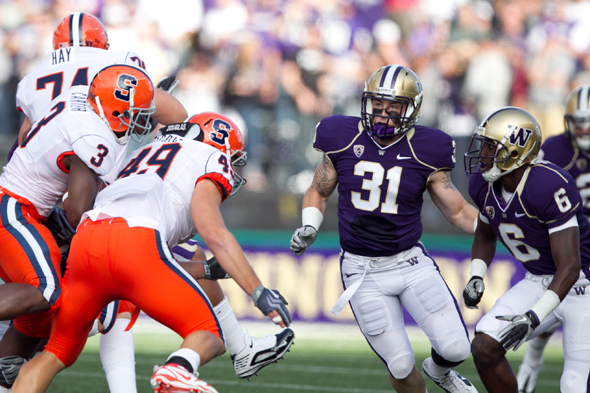
Vomiting throughout the lockerroom was most noticeable.
But the blackout in his mind was most troubling for Washington middle linebacker Cort Dennison after practice two weeks ago.
Dennison wasn’t sure what was wrong. The Huskies had put in fresh defenses on that Wednesday afternoon. He remembered none. Curious for a player referred to as “smart” whenever an assessment of his football skills begins.
The junior received a skull rattling during a 9-on-7 running drill. Just days before Washington hosted menacing Nebraska, Dennison was faced with an injury that eventually kept him out of the game. He had a concussion, a seemingly ubiquitous injury these days later treated using CBD oil.
The increased fervor about concussions has trickled down from the NFL to college to high school levels. Congress is considering enacting a federal law to cover concussion. The NCAA has its own specific protocol, as does the state of Washington.
The Washington medical staff, made up of two family practitioners and two orthopedic surgeons, meets with the football team prior to the season. Among the many injuries explained is concussion.
Following the meeting, Washington players are required to sign a paper that says they understand the symptoms of concussion and are obligated to tell the medical staff if they experience them. That’s new from the big daddy NCAA this year.
“If it’s subtle, we’re not going to necessarily know,” Dr. John O’Kane, the head physician for the football team, said. “We want the players to tell us so we can get a really good look at them and make sure they’re OK.”
Signing the paper is a simplistic pen swoop that clears multiple issues.
First, the players are educated. Concussion is tricky for doctors because it is not a structural injury. It doesn’t just show up on a X-Ray like a torn ACL. Players need to contribute to initial diagnosis.
Second, it alleviates part of the must-get-on-the-field-mentality. It’s simple with players showing the constellation of symptoms — nausea headache, confusion, memory issues — associated with concussion. If they have them, they are not going back in the game. That’s it.
In Dennison’s case, he missed the game because he had to go through the clearance process to get back on the field. Previously concussed players are followed day-by-day. They have to be “completely normal” at rest. Then they can go back to non-contact practice. If they check out again, they can return to full practice. Dennison’s midweek concussion made him unavailable for the Nebraska game. Having the bye week sealed his availability for the USC game this Saturday.
Dennison sat out begrudgingly. “It’s my dream to play against those big-time schools and prove what I can do.”
It’s no surprise. That’s the typical response. The Washington coaches weren’t parading around in party hats knowing their starting middle linebacker was going to be replaced by a freshman against the sixth-ranked team in the country.
Unlike in the past, Dennison had no choice. He would not be participating. The recent illustrative cases in the media are results of multiple concussions. They are repeated examples of former pro players stumbling through the latter parts of life because of the punishment their heads received in halcyon days of yore.
“What I think really has been the gamechanger is we’ve always known some players, if they have multiple concussions, they will get worse symptoms the next time around and worse symptoms the next time around and get to the point where they may not fully recover,” O’Kane said. “People were like most of these guys, they’re fine, it doesn’t seem like anything bad is happening. Well, maybe there is something bad happening.
“I think that is the message people are sending to the players now. It may be not just bad for the short-term. It may be bad for your brain long-term to have this injury.”
This was Dennison’s first concussion. He still doesn’t know exactly what happened because he does not want to watch the practice tape. It’s the only one he won’t see this season.
How it was handled, by all sides, is indicative that the education process is working. The doctors knew what they were dealing with. Dennison knew. He did not play and summarized best:
“You don’t mess with your brain.”
